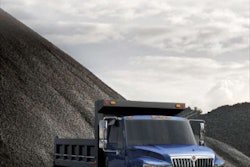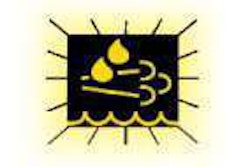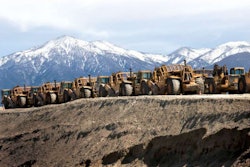Mixed-service tires
When your trucks work on and off the road you need a tire that’s tough and flexible.
By Tom Jackson
A tire program for trucks that never leave the pavement is pretty simple. But tires for dump trucks, concrete mixers, or trucks in earthmoving, logging, mining and quarry applications face a dual set of challenges. They have to be tough enough that they don’t rapidly wear out on the highway, yet flexible enough to deform around rocks, roots, rebar and other hazards in the off-road arena.
 Soft dirt is easy on tires, but can hide rocks, roots and rebar, which calls for tires with enhanced cut and chip resistance.
Soft dirt is easy on tires, but can hide rocks, roots and rebar, which calls for tires with enhanced cut and chip resistance.In many cases, these tires are going to be run to destruction. But by understanding the latest design and technology used in these tires, by carefully matching the tire to applications and with good maintenance and a retread program, you can maximize your uptime and mileage and minimize costs.
Cut and chip resistance
Mixed service tires, sometimes referred to as on-off road tires, achieve cut and chip resistance by being more flexible and using more natural and less synthetic rubber. But that comes with trade-offs. “If you built a tire out of all natural rubber, it would be very hard to cut it,” says Gary Hendricks, truck tire sales manager for Toyo Tires. “But it wouldn’t wear very long. Natural rubber has a faster wear rate than synthetic rubber.”
So tire manufacturers spend a good deal of time developing proprietary “compounding formulas,” compounding being the mix of natural and synthetic rubbers and chemical additives. These formulas are closely guarded secrets, but the main goal of each is to balance highway mileage with enough flexibility to be able to survive harsh off road environments.
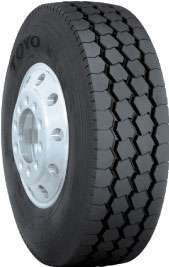 The Toyo M320Z is a premium mixed service tire that is rugged enough for a variety of conditions and specifically designed for logging, mining, concrete mixers, refuse, dump trucks, and similar harsh service applications.
The Toyo M320Z is a premium mixed service tire that is rugged enough for a variety of conditions and specifically designed for logging, mining, concrete mixers, refuse, dump trucks, and similar harsh service applications.Mixed service tires also use a different casing architecture. Many mixed service tires feature reinforced sidewalls to combat debris and other off-road hazards that might cut, scrape or puncture an on-highway tire, says Chris Tolbert, business segment manager, Michelin America’s Truck Tires.
The tire and sidewall also have to have more flex than a typical highway tire. “Your typical steel belted radial highway tire can be very stiff,” says Guy Walenga, director of engineering, commercial products at Bridgestone. “When you roll down a paved road you don’t want the tire footprint to be distorted, and that’s what the belts do. But when you’re off the road you want the tire to envelope over things, you don’t want it to hit things and have resistance – that’s when you get cutting and chipping.” But a more flexible tire will scrub more and scrubbing removes tread – so as with compounding, a balance has to be sought between protection and mileage.
Over the past decade or so, the formulas and designs of mixed service/on-off road tires have been changing. In the past it was assumed that tires for dumps, mixers and other construction trucks should be designed for use 50 percent on road and 50 percent off road. “We’ve found over the years that tires don’t spend this on-off road quotient at 50/50,” says Walenga. “It’s usually more like 80/20 or 90/10, with most of that time being spent on road. So we were able to change the construction and the compounding to give us better highway mileage. The highway mileage has improved, but we managed not to give up any of the chip and cut resistance or casing durability or traction.”
Tire type and position
On certain types of jobsites, such as soft dirt, you may need a dedicated traction tire for the drive axles, but otherwise most trucks can be fitted with all-position tires on any axle. “The drive tires are more of a lug design, very aggressive, deep tread that improves traction in deep, soft dirt, muddy conditions or deep snow off road, says Tim Miller, marketing communications manager at Goodyear. “All-position tires tend to be a rib or rib type tire with some variations, and can be used as a steer, trailer or drive tire.”
It’s also acceptable to rotate on-off road tires to even out the wear, depending on the original tire and its position. “You might rotate a steer axle tire from side to side and rotate your drive tires in an X pattern just as you would for a highway tire,” Walenga says. That way you get even wear and replace them as a set rather than four at a time or two at a time.
Longevity
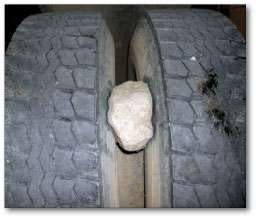 Careful and frequent inspections of mixed service tires will prevent unseen hazards like this rock from destroying a still-serviceable tire or damaging the casing so much it can’t be retreaded.
Careful and frequent inspections of mixed service tires will prevent unseen hazards like this rock from destroying a still-serviceable tire or damaging the casing so much it can’t be retreaded.A drive-axle tire on a highway truck can go 350,000 to 400,000 miles, but you won’t get that kind of mileage on a mixed service tire, says Miller. But quoting numbers will paint you into a corner, he says, and it’s a fairly good assumption that most mixed service tires will run to destruction. “Damage is a bigger problem than tires wearing out,” he says.
“We get that question (about longevity) all the time, but we have no idea,” says Walenga. “We can look at what you’re currently running and make a couple stabs at it. But if it’s a new type tire you have to put it on and run it in your applications, with your maintenance procedures and keep good records before you can have a good estimate.”
Maintenance
Just because on/off road tires are more susceptible to road hazards, does not mean you can neglect their maintenance. The reverse is true. Good maintenance and attentive drivers will do more to extend the life of your mixed service tires than anything else you can do.
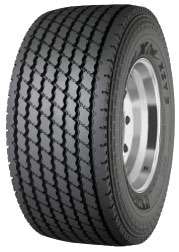 Michelin’s X One XZY3 wide single tire is an all position radial with a flat contact patch and variable pitch groove walls and groove bottom protectors in the center grooves for protection against stone drilling. A reinforced bead package leads to greater durability and resistance to heat.
Michelin’s X One XZY3 wide single tire is an all position radial with a flat contact patch and variable pitch groove walls and groove bottom protectors in the center grooves for protection against stone drilling. A reinforced bead package leads to greater durability and resistance to heat.First and foremost is air pressure maintenance. “The air is what carries the load,” says Hendricks, “and a heavier ply rating means you can put more air in it. A big mistake customers make is that they’ll buy a 16 ply and only put 100 pounds of pressure in it, so they’ve effectively made it a 14-ply tire because of the air they’ve put in it.”
Mixed service tires should also be inspected on a regular basis to remove any debris or stones from the tread areas and from between duals in a dual tire assembly, says Tolbert. Regularly cleaning the tires will help keep the rubber from premature aging caused by dirt or other debris being held against the rubber, he says.
Alignment should be checked frequently as well, Walenga says. “Being off road means the truck is going to work the suspension hard and it might be a little more difficult to keep those trucks in alignment. When you stop to fix mechanical problems like bent tie rods or broken shock absorbers, be sure you check the alignment as well.” Likewise, repair small cuts and punctures to the tires as soon as possible, to prevent moisture and dirt from getting into the tire and rusting the steel belts or degrading the casing.
Retreads
Any fleet manager worth his or her salt knows the value of a good retread program, but with mixed service tires getting fewer miles than tires on highway trucks, a retread program is even more important. And the quality and beefiness of a mixed service casing makes it a great candidate for retreading.
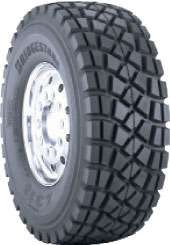 The Bridgestone L315 is designed for axles carrying extra-heavy loads where extra traction is required. The wide footprint increases flotation while allowing a higher payload – up to 12,300 pounds at 120 psi.
The Bridgestone L315 is designed for axles carrying extra-heavy loads where extra traction is required. The wide footprint increases flotation while allowing a higher payload – up to 12,300 pounds at 120 psi.“You can buy a retread for a third of the cost of a new tire, so there is no reason not to do that,” Miller says. “If the casing is OK you’re going to tend to get more retreads out of the mixed service tire than an over-the-road tire just because it doesn’t have that many miles on it. In the trash haul industry getting up to six or seven retreads out of a casing isn’t uncommon.”
Tire damage from harsh environments will reduce your chances of retreading a tire, says Hendricks. “But if it’s a dump truck that’s in the soil a lot and the tread is just worn out, it makes a great case for retreading.”
Walenga urges fleet managers to pull mixed service tires for retreading earlier than you would for a highway tire. A typical highway tire can wait until the tread is 2/32-inch deep in the drive and trailer positions, and 4/32-inch for steer tires and still be legally retreaded. But running a tire this thin in severe service applications is asking for trouble. Many fleets use 6/32-inch as a common pull point, Walenga says, but he cautions that 8/32-inch might be better for on-off road tires. “As the tread wears down there is less material to protect the tire casing and still and it could be penetrated more easily,” he comments.
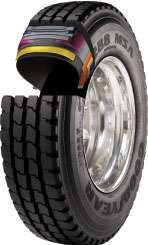 The Goodyear GS296 MSA mixed service tire has an optimized footprint for enhanced traction in steer and drive positions. It’s also available in Goodyear’s Duraseal technology (shown in the cutaway) that seals punctures up to ¼ inch in diameter in the tread area.
The Goodyear GS296 MSA mixed service tire has an optimized footprint for enhanced traction in steer and drive positions. It’s also available in Goodyear’s Duraseal technology (shown in the cutaway) that seals punctures up to ¼ inch in diameter in the tread area.This is an economic decision as well as a practical one, and Walenga recommends you talk to your tire dealer, research your scrap pile and keep records on when and why your tires are coming out of service. “If you’re seeing too much damage with the treads at 5/32-inch, maybe you start pulling them out of service at 7/32-inch,” he says. “You have to do some investigation and define when these tires need to be pulled so that it’s economically feasible and you still keep the casing.” EW

